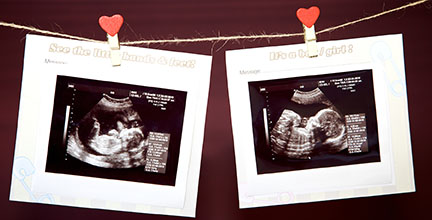
The Abortion Pill, also called a medication abortion or the chemical abortion regimen, has many significant risks. A new study based on actual medical insurance claims has uncovered crucial data.
If you started a chemical abortion but now regret it, Abortion Pill Reversal offers hope.
24/7 Helpline:
1-877-558-0333
TRUTH:
1 in 10 women experience serious complications after taking the abortion pill.
Recently, a study was done in the United States by the Ethics and Public Policy Center compiling information from insurance claims for chemical abortions. There were 865,727 cases, the largest study ever done before in the U.S. on the effects of the abortion pill. Results showed that 10.93% of the women experienced sepsis, infection, hemorrhaging and other serious events within 45 days following a mifepristone abortion. This is an unacceptable rate of 11% for serious damages from medical procedure.
In West Virginia, by law, these abortions can no longer be performed; but women are traveling out of state to places where they are being done. Based on this data, 11% of these women will travel back to West Virginia where they will require care in the West Virginia medical system. Many states, including Maryland and Pennsylvania, have put laws on the books that are designed to protect the abortionists from out of state suits. For example, it is against Maryland law to transfer abortion records of West Virginia women back to their home state. These have been called “shield laws” designed to “shield” abortionists from being held responsible for the damages they cause.
Women are being abused by abortionists and their supporters.
Don’t Swallow the Lie.
Shanyce’s Story
Shanyce shares a deeply personal and harrowing account of her chemical abortion experience. After taking the abortion pills, she endured extreme physical pain, bleeding, and emotional trauma—alone and unsupported. Her testimony highlights the lack of informed consent and medical supervision that often accompany at-home abortions.
Read Shanyce’s Full Story
Planned Parenthood Dismissed Her Concerns—And She Almost Died
NRL News, Jun 18, 2025
A woman suffered severe complications from the abortion pill and Planned Parenthood sent her home when she sought help
By Sarah Terzo
Pro-life organizations have been talking about a recent study [Alicia has the PDF; post it on our site in a “More Information” tab, link to it there; public link to PDF tends not to work] on abortion pill complications. The study found that 10.93 percent of people experience sepsis, infection, hemorrhage, or another serious adverse event within 45 days of taking the abortion pill.
It also found that the rate of serious adverse events following chemical abortions is at least 22 times higher than the figure of “less than 0.5 percent” reported on the drug label.
When examining numbers and statistics, it’s easy to lose sight of their impact on individual people. What do these complications look like for individual women?
An Abortion Pill Complication
One woman’s experience gives us an answer. On a webcast (Just Shanyce’s story: https://nrlc.org/nrlnewstoday/2025/03/woman-describes-harrowing-abortion-pill-experience-i-nearly-died/; the whole webcast: https://www.davidbereit.com/exposed-event?cid=6923769a-44af-4bd2-89f6-d69a4aab2ebd&eoid=2149395451)
hosted by David Bereit, a black woman named Shanyce told her story. Shanyce took the abortion pill and almost died from a life-threatening infection.
Many women have written about being ambivalent, upset, or emotionally distraught before having an abortion. But when Shanyce went to Planned Parenthood to get the abortion pill, she wasn’t emotionally troubled. Instead, she says, “I really didn’t have…no emotion. You’re here. Just get it done.”
The abortionist at Planned Parenthood gave her the first abortion pill, mifepristone, which she took at the facility. She took home the second drug, misoprostol, and took it 72 hours later.
Shanyce began to bleed heavily and cramp. At first, she thought everything was fine. Planned Parenthood workers had warned her that she would have cramps. She says she thought, “Okay, like, this is what they said was gonna happen. Like, these are the symptoms, so I’m fine.”
But then the cramps got much worse. Shanyce recalls:
[T]he cramp was unbearable… [I]t kind of felt like somebody was stabbing me in my stomach… It was really unbearable. I never cramped like that before.
Seeking Help at Planned Parenthood
Shanyce’s mother became worried. She told Shanyce to go back to Planned Parenthood because she shouldn’t be in so much pain.
Shanyce did go back to Planned Parenthood, and they did an ultrasound. The same doctor who gave Shanyce the abortion pill told her that there were no fetal remains left in her uterus and the abortion was proceeding as normal.
According to Shanyce:
They kind of like, just brushed it off and was, like, Hey, these are the symptoms. Like, you’re fine. And she just sent me about my way.
So, I go back home, I called my mom, and I told her what happened, and she was just like, “Well, we’ll just wait and see if the pain go[es] away, like, take some Tylenol or Advil.”
It was close to the holidays, and Shanyce’s family was supposed to have photos taken, but Shanyce was too sick.
An Emergency Trip to the Hospital
At some point, her mother insisted that she go to the hospital. Shanyce said her mother noticed that she was “blue, pale… I just looked really lethargic and sick.”
At the hospital, doctors did another ultrasound and discovered that the Planned Parenthood abortionist was wrong – there were parts of the baby and/or placenta left in Shanyce’s uterus. This retained tissue had caused a serious infection.
Shanyce was put on an IV and rushed into surgery. She describes what happened next:
…I started getting a fever. I was throwing up constantly. I remember the first three surgeries that I had to remove the remains of the child, all my family came. They prayed over me, and that was kind of like the last thing I remember from there.
Shanyce went into septic shock, and doctors put her into an induced coma while they struggled to save her life.
She came very close to dying. According to Shanyce:
I nearly died. I was there for maybe a week or so. They kept me, and then they wanted to transfer me to another hospital, maybe, like, an hour away. I was still in a coma…
I wake up in ICU, on a breathing tube. [I had a] blood transfusion. I had a stent in my neck so they could do blood work and all this other stuff, and I wasn’t able to talk until, like, the next day.
Her mother and father stayed in the area and sat vigil by her bedside until she woke up. Talking to her mom after waking up from her coma was, according to Shanyce, “very emotional for us.”
Devastating Consequences
Shanyce had to have a partial hysterectomy. She may never be able to have children.
Her recovery took a long time, and she needed occupational and physical therapy. She says:
They showed me how to step in and out of the shower, how to brush my teeth. I had to learn how to walk again …[I] had to learn how to write, chew, talk a little bit, how to do daily things. I didn’t go home til maybe the last week of February, and I was there from the beginning of January.
Shanyce had been so sick that she needed to be rehabilitated – taught all over again how to do simple things like walking, eating, and showering.
This all happened due to the abortion pill. Needless to say, Shanyce was not warned of the risk at Planned Parenthood. When she went back seeking help, the doctor at Planned Parenthood sent her home.
Had her mother not insisted that she go to the hospital when she did, Shanyce would likely have died. As it was, she came very close to dying anyway.
Currently, no government statistics are being kept on abortion pill complications. We have no idea how many women have endured serious complications, as no one is keeping track.
This appeared at Sarah’s Substack. You can read more of her articles here.
LIE:
The abortion by pill protocol is very safe and very simple, like a heavy period.
TRUTH:
Bleeding lasts on average, nine to 16 days. 8% of women bleed more than 30 days, and 1% require hospitalization because of heavy bleeding.
– Dr. Athony Levatino
Dr. Anthony Levatino, abortionist turned pro-life activist, on abortions by pill:
By Sarah Terzo, NRL News, November 12, 2021
24 – 48 hours after taking RU-486, the woman takes misoprostol, also called cytotec, that is administered either orally or vaginally. RU-486 and misoprostol together cause severe cramping, contractions, and often heavy bleeding, to force the dead baby out of the woman’s uterus.
The process can be very intense and painful, and the bleeding and contractions could last from a few hours to several days. While she could lose her baby at anytime and anywhere during this process, the woman will often sit on a toilet as she prepares to expel the child, which she will then flush.
She may even see her dead baby within the pregnancy sac. At nine weeks for example, the baby will be almost an inch long, and if she looks carefully, she might be able to count the fingers and toes. After she has disposed of her baby, the woman may have bleeding and spotting for several weeks.
Bleeding lasts on average, nine to 16 days. 8% of women bleed more than 30 days, and 1% require hospitalization because of heavy bleeding.…
The failure rate increases as the pregnancy progresses. At seven weeks, it is a 5% failure rate, at eight weeks an 8% failure rate, and at nine weeks a 10% failure rate. If failure occurs, she will usually be offered a surgical abortion.
For the mother, medical abortion often causes abdominal pain, nausea, vomiting, diarrhea, headache, and heavy bleeding. Maternal deaths have occurred, most frequently due to infection and undiagnosed ectopic pregnancy.
LIE:
No need to see a doctor or have an ultrasound before a chemical abortion
TRUTH:
Maternal deaths have occurred, most frequently due to infection and undiagnosed ectopic pregnancy
– Dr. Athony Levatino
Quick Facts About the Abortion Pill
The Abortion Pill, also called a medication abortion or the chemical abortion regimen, has many significant risks. A new study based on actual medical insurance claims has uncovered crucial data.
If you started a chemical abortion but now regret it, Abortion Pill Reversal offers hope.
24/7 Helpline: 1-877-558-0333
How abortion pills work.
The woman takes mifepristone (generic for Ru-486) pills at the clinic, which block the action of progesterone, the natural hormone vital to maintaining the rich nutrient lining of the uterus. The developing baby starves as the nutrient lining disintegrates. The woman is given pills to be taken at home the next day. The pills are a dose of artificial prostaglandins, usually misoprostol, which initiates uterine contractions to expel the body of the embryonic baby. The pills trigger delivery of the baby and placenta, but the contractions can be more painful because they are induced chemically. At least 4% of women using this method must return for surgical abortions, due to incomplete expulsion of tissue.
Women lose more blood from a chemical than a surgical abortion. Chemical abortions take longer to complete than surgical ones.
Not counting recovery time, surgical abortions may take maybe 10 minutes to complete, so that a woman can be in and out of a clinic in a couple of hours10. Chemical abortions involve multiple drugs taken over a number of days and may take days or weeks to be fully completed.
Medication abortions have a significant failure rate.
The FDA warns these drugs fail to deliver a complete abortion 2-7% of the time12.
A recent analysis released found that more than one in 10 women experienced a “serious adverse event” after taking the mifepristone abortion pill in 2023.
Click Here to Read Full Article
The warning signs of ectopic pregnancy are disturbingly similar to chemical abortion side effects.
If a woman has not had a physical exam, there is no way of knowing if she has an ectopic pregnancy, the baby is developing outside the uterus. Because women having drug-induced abortions normally face considerable abdominal pain and bleeding, patients and even doctors who have not seen an ultrasound have missed these danger signs of a rupturing ectopic pregnancy.
Several mifepristone users came down with serious bacterial infections.
A number of women taking mifepristone died after contracting Clostridium sordellii, an anaerobic bacteria that thrives in oxygen-poor environments where there may be an open wound.
Bleeding can lead to life-threatening hemorrhage.
Every woman going through a chemical abortion does a considerable amount of bleeding, but when this bleeding is heavy and does not stop, she can be in serious danger if she does not get surgical treatment.
LIE:
Medication abortion is very safe. In fact, it’s safer than many other medicines like penicillin, Tylenol, and Viagra.
Planned Parenthood
TRUTH:
Chemical abortions aren’t medicine. They are a poison that kills unborn human beings. They are especially dangerous when sent through the mail and ingested at home without supervision or in-person evaluation.
Listen to MacKenna describe her own personal experience
“I did take the first pill in that protocol. Immedicately from taking it and in the days leading up I knew that was not a right decision for me but I continue to convince myself that it was right decision . . .Once I let reality hit me that was a major mistake. I reached out to Abortion Pill Reversal and they provided me with life saving care.
“I get to look at her beautiful face today. So I want every women that was ever in my position to know that this is an option and it clearly works.”
TAKEN THE ABORTION PILL? It may not be too late.
Statewide Don’t Swallow the Lie Billboard Campaign NEEDS funding
For More Information




